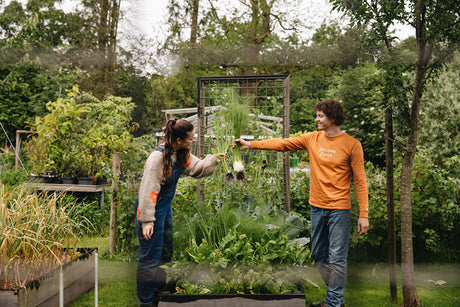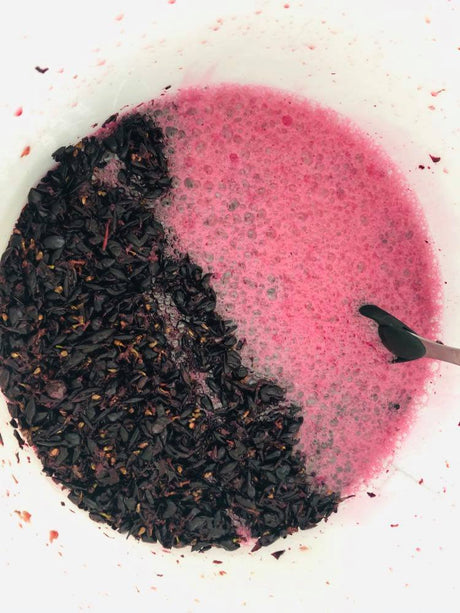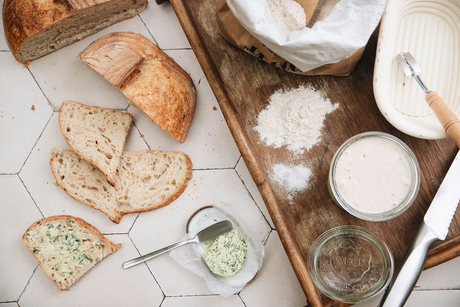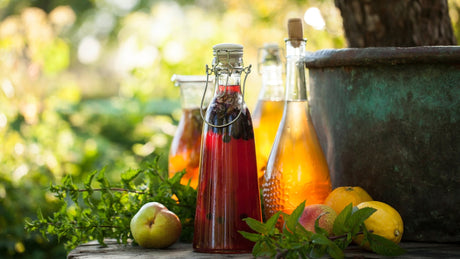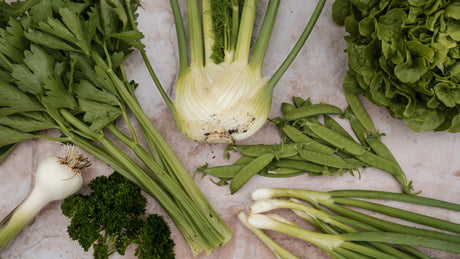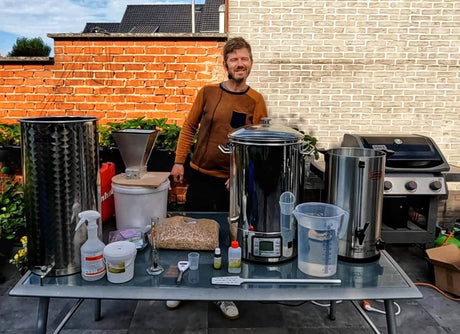Using lava flour in the vegetable garden - part of the vegetable garden success formula
When we grow organic vegetables, we all have a common goal: Grow healthy vegetables. But perhaps even more important is building a healthy vegetable garden soil to grow your vegetables in. Building, not with bricks and mortar of course, but with organic material, humus, nutrients including a very important one: minerals. And an excellent way to get minerals into the soil is to work in lava flour . Lava grit or coarse lava flour breaks down more slowly in the soil and fine lava flour is a bite-sized chunk for your vegetables. An excellent way to keep your vegetable garden soil in top shape is to regularly add minerals in the form of lava flour . Using lava flour in the vegetable garden is an essential part of a successful formula for your vegetable garden soil. In my Ebook ' My organic vegetable garden ' I explain all the components of the vegetable garden soil step by step. It is very easy to read and is free. I recommend that you definitely download it and read it. Knowing your soil is already more than half of the vegetable garden work. It will not only help you to grow healthy plants but a balanced vegetable garden soil also protects against diseases. If you also want a healthier soil to grow in, then read on... lava flour as a nutrient in the vegetable garden
lava flour as a nutrient in the vegetable gardenWhy add minerals from lava flour to the vegetable garden
Plants and trees can do a lot, they are often very intelligent machines that can convert nitrogen into oxygen and vice versa. When plants die, they form organic material for the soil again, but there is something they cannot do, create minerals. Agreed, the minerals that are in a dead plant go back into the soil, but they were not really created by the plant. Just borrowed and returned. Where do the minerals from our vegetable garden soil come from? They come from natural phenomena that sometimes occurred millions of years ago. When rock formations flew around due to geological movements and were transported by rivers or meltwater from glaciers. Also by volcanic eruptions and that is the basis for our mineral bomb for the vegetable garden, lava flour .What is lava flour ?
That it must be good for the vegetable garden, you probably already figured that out. I've been working on that for three paragraphs already. Lava flour is ground lava rock that is freshly prei d by a volcano (or rather 'fresh prei d was'), otherwise it would be quite hot in your vegetable garden). Rock minerals are indispensable in your vegetable garden but not all ground stones are the same. Lava rock has the highest concentration of minerals, which means that they offer the most benefit in the garden. A volcano spews out primeval rock that is full of minerals
A volcano spews out primeval rock that is full of mineralsHow does your vegetable garden soil benefit from lava flour or basalt flour ?
Understanding how your vegetable garden soil is helped by lava flour is simple. The roots of plants are greedy and absorb minerals from the surrounding soil. But after a while, the mineral reserves run out. After a crop of cauliflower, for example, you can assume that quite a few minerals have been absorbed by your cauliflower plant. The crops after that will never be as successful unless you add a new dose of lava flour to your vegetable garden beds. The rock flour ensures strong plants with thick cell walls that are therefore less susceptible to diseases and pests.combining lava flour into a successful formula for the vegetable garden
Imagine, you have a new piece of land that is full of horsetail , thistles and other weeds. Is it then sufficient to work lava flour into your soil to guarantee success? No, in a poor sandy soil without organic material, humus, NPK nutrients, minerals and trace elements your lava flour will simply wash away towards the groundwater. Your plants will look very pale and you will send me an email: "Tom, lava flour is rubbish, nothing grows in my vegetable garden". Or something like that. But what can we do now to bring our vegetable garden soil into top shape.Every soil is different
Before I give you any specific tips, you should understand that every soil is different. When I started my vegetable garden, I had a 100% sandy soil with 0% humus and organic material. There was a fair amount of nitrogen in the soil, phosphorus and potassium present in my vegetable garden. I also had some minerals such as magnesium and calcium in the soil. Below is the soil test that I had done in 2015: The results of my vegetable garden soil in 2015
The results of my vegetable garden soil in 2015My soil strategy and success formula
Without guaranteeing that you will not encounter any harmful insects or that a crop can simply fail, I will give you my basic strategy for a vegetable garden soil in top shape below. It is not correcting or compensating, which is sometimes necessary, but a basic soil strategy. Apply the three basic building blocks to your soil and work everything into the soil with a Spade fork .Building Block 1: Adding Organic Matter to Your Soil
To start I would work in a 5 to 15 cm layer of compost or soil improver with a pitchfork , depending on how much you have available. I love peat compost because it gives results very quickly. I mix half of it with coconut soil , coconut soil decomposes a little less quickly and gives a spongy structure to your soil. The combination of peat compost / coconut soil is great! The peat compost from Moestuinweetjes comes from sustainable exploitation in places where old forests are being replaced and new forests are being planted. The old layer of forest soil must be removed here in order to be able to plant new trees. And we can use that in our vegetable garden. Be careful with compost from your compost barrel, it can contain a lot of sprouting seeds from weeds, tomatoes, pumpkin remains, ... choose good compost that has been tarred by heat. The compost from your compost barrel can be very useful for making compost tea. For this you fill a nylon stocking with compost and hang it in a watering can or bucket of water. This is how you sieve out the seeds .Building block 2: NPK organic fertilizer granules for vegetable garden
NPK stands for the three basic growth substances for our vegetable garden. N stands for nitrogen and ensures a beautiful green leaf, P stands for phosphorus and serves for a good root system and K stands for potassium (also called potassium) helps your plant with its general health and especially with flower and fruit formation. The packaging of the fertilizer granules states how many grams per m² you can administer for an optimal start. This amount differs according to the crop you want to grow.Building block 3: lava flour for a range of minerals and trace elements
Iron, manganese, chlorine, sodium, chromium, germanium, iodine, cobalt, zinc and magnesium are just a few of the essential elements in your vegetable garden soil. All chemical processes in your plants use N, P, K, minerals, water, air and so much more to create tasty vegetables. Just think of the construction of countless vitamins or the production of chlorophyll in which magnesium and nitrogen work together with a few other components to ensure photosynthesis in your plants. Photosynthesis is, in short, the process in which the sun's rays are converted into fructose (sugar). So add 250 grams of lava flour per square meter as a basis for your vegetable garden. Your vegetables will be oh so grateful. Do not work the lava flour with a pitchfork but rake it into the top 5 cm of your soil. In planted beds, you can simply sprinkle it on the ground, avoid contact with the root system.And what do you do in the years that follow?
The nice thing about the above base is that you only have to work the 3 building blocks in once. The following years you simply place it in a layer around your vegetable garden soil . 5 to 15 cm of compost ; organic fertilizer pellets for vegetable gardens (quantity according to packaging per crop) and 250 grams of lava flour per square meter. Some people also add some lava flour to the planting hole or in the sowing groove, but that is optional. You can mix the organic fertilizer pellets for vegetable gardens and lava flour in advance in your wheelbarrow, so you don't have to rake anymore and you can leave the soil that is now full of soil life, nicely alone.mix lava flour into your compost
You know how it is, the kitchen waste is perhaps a bit too much and there is less brown material in your compost than you would like ... The compost is full of flies and does not smell so nice. There are even few worms present in the top layer. What you can do in this case to turn the situation around is to mix 10 kilos of lava flour per cubic meter . For a 200 liter compost barrel that is half full and stinks for hours in the wind, you can mix 1 kilo of lava flour under your compost . The composting will be stimulated, the smell will disappear and the worms that were hiding in the bottom layer can once again produce plenty of humus. When you compost lava meal it breaks down and is even more ready for your plants. It is already mixed in immediately.When to apply lava flour
It is no longer a secret that lava flour can make a huge difference in the vegetable garden. But when can you start using it? The application is actually ideal in the spring for soils with little humus and organic material. If you use it on those soils in the fall, a lot of lava flour will have been washed away before it can prove its worth. If you have a soil that has been fertilized with compost for years and contains a lot of humus, then it is ideal to work it in together with manure or compost in the fall months.Using lava flour as a pesticide
The leaves of your plants are constantly exposed to the air and the sun. This is also very important for the photosynthesis process. But at the same time, your leaves are also exposed to 1 major danger: fungi. Mildew, downy mildew and phytophthora (the latter is technically not a fungus, but that would take us too far). To prevent fungi, you can use a powder sprayer to spray basalt flour or lava flour on the leaves of the plant. This wafer-thin layer of dust will protect your plants from fungi.When does lava flour not work?
Earlier I talked about the 3 building blocks of the vegetable garden soil success formula: compost , organic fertilizer granules and lava flour . Compost is a very important one here, without compost you will not benefit from your lava flour . How does it work? Lava flour needs soil life to be broken down into bite-sized mineral delicacies for your plants. Soil life only lives in soils with a lot of organic material such as compost or soil improver. So if you freshly spread your lava flour in poor sandy soil without organic material, you could have saved yourself the trouble. Nothing will happen. Another case where lava meal doesn't work, worse, it works in a negative way. Bad compost , compost that is not sufficiently decomposed or anaerobic compost (that stinking compost where all soil life flees) will need your lava meal to neutralize just like nitrogen (N) from the soil and takes the minerals out of your compost , gone. Your plants can no longer absorb the lava meal .buy or order lava flour
It is important to work with quality products. Ground concrete is sold as lava flour on web shops. So make sure you get the pure stuff. In our web shop you will find lava flour and basalt flour with a guaranteed composition that will provide you with the minerals that will boost the production of your vegetable garden. The powder sprayer is also used to work preventively against fungi. BIO lava flour Humuforte
BIO lava flour HumuforteFinally
I didn't think I would be able to write more than 2000 words about lava flour but the more I read, the more I learn about this very valuable product. Myself in my vegetable garden

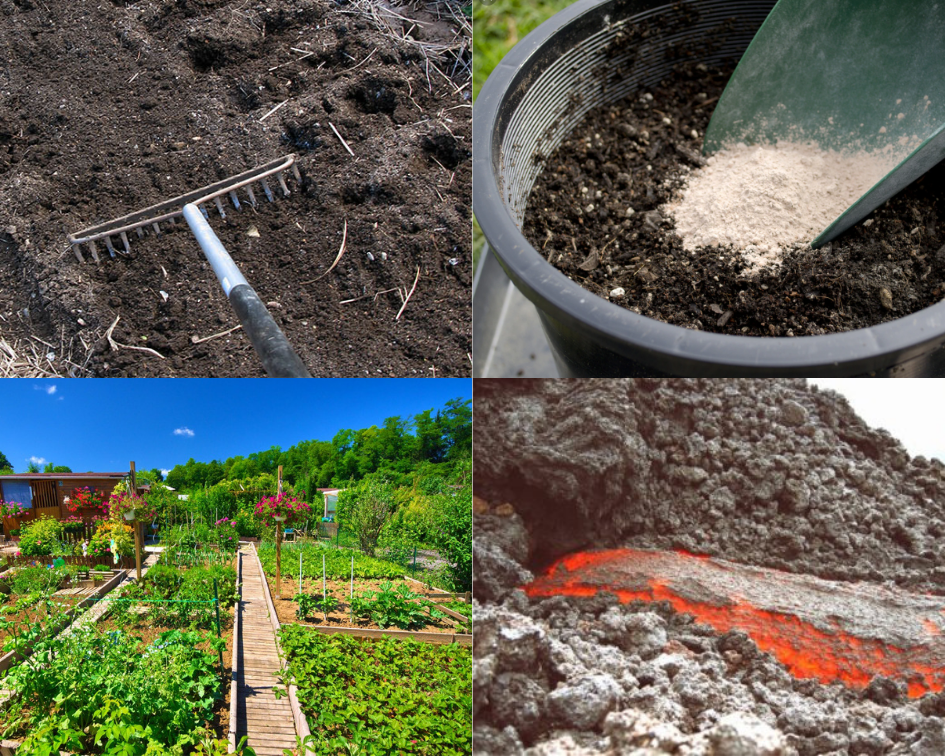
 mix
mix 

